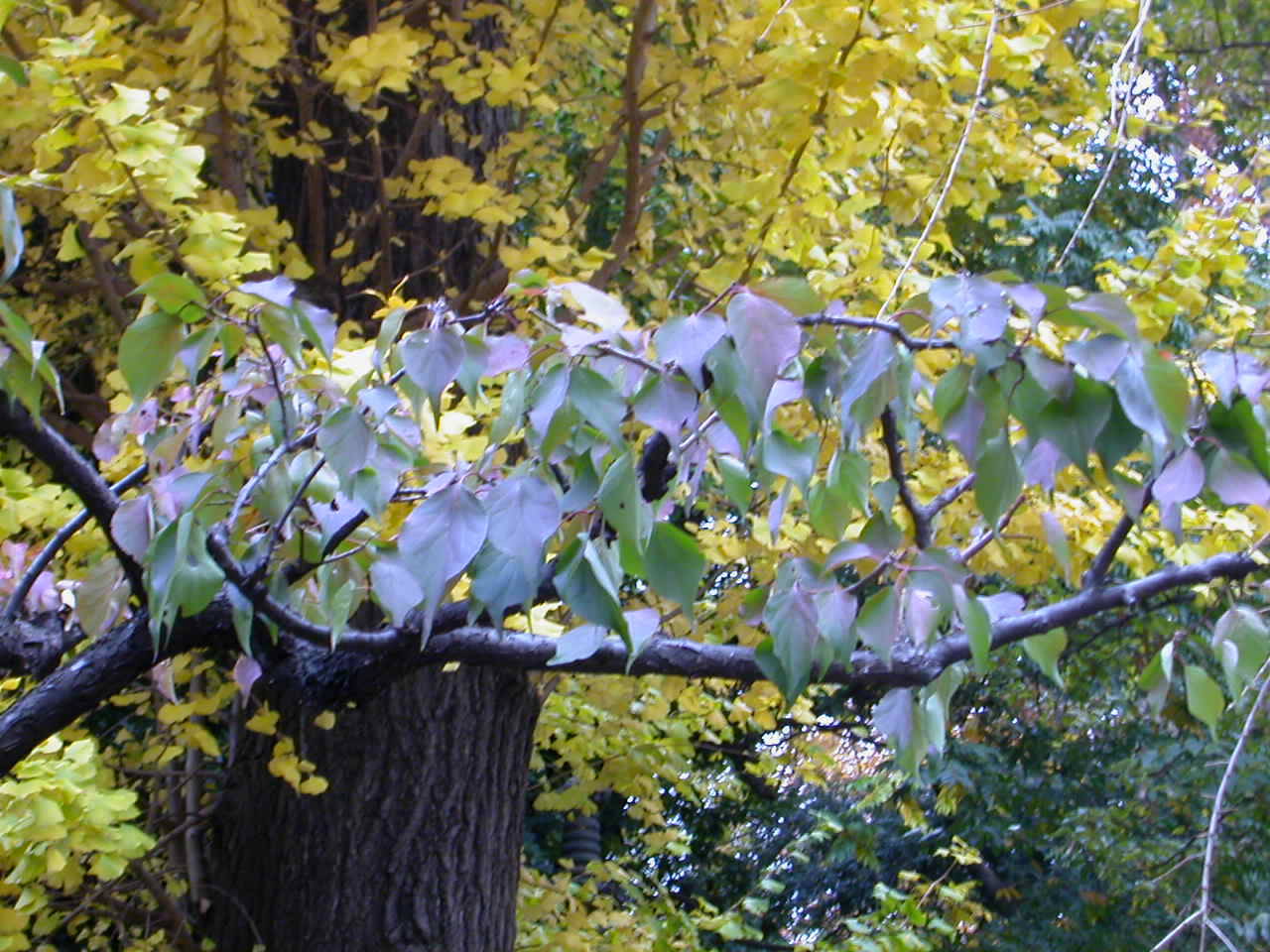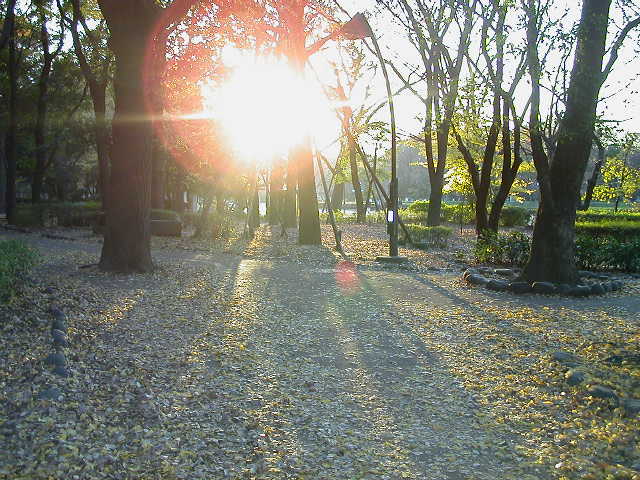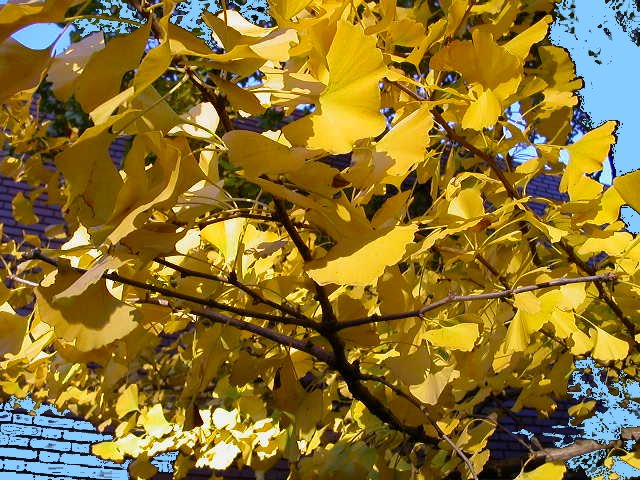RECENTLY I STARTED TAKING ONE TABLET OF GINKGO BILOBA EXTRACT EVERY DAY, TO SEE IF IT CAN MATCH THE MIRACULOUS RESULTS I HAVE EXPERIENCED FROM USING TWO OTHER CHINESE HERBS -- GINSENG AND GREEN TEA. The tablets themselves were ridiculously cheap -- I bought a bottle of some 40 or 50 pills at a 100 Yen ($1) Shop in Tokyo, meaning they roughly costed about 2 cents a pop. From that tiny investment, I have already noted a huge improvement in my cognitive processes. I was already getting incredible results from a weekly ginseng regimen of ginseng consumption which I launched a couple of months ago. It seems, however, that these 2 cent Gingko pills I have begun swallowing every day have somehow multiplied the ginseng effect, and taken me into a higher level of cognitive excellence. The sense of clarity I have gained really is incredible. At times I have been walking through the busy streets of Tokyo and suddenly some ginseng/ginkgo chemical alliance will spring into effect, and I am aware of everything in an almost painfully powerful way. The colors of the traffic lights are so strong they are almost burning into my eyes. This must indeed be the way a young child sees the world, before their brain gets burned out -- or the viewpoint of an enlightened being. In this ginseng/ginkgo high, every moment becomes filled with wonder. Normally mundane sights -- apartment towers, passing cars, advertising signs -- are suddenly invested with a kind of spiritual beauty. I feel like I could, to paraphrase UG Krishnamurti, count the hairs on the head of someone 200 metres away from me. And more and more, since I started taking ginseng only four or five days ago, I have begun remembering things I had forgotten about long ago. Memories of childhood suddenly spring into my mind in amazing detail. This is testament to ginseng's memory enhancing powers, which I want to discuss on this website.
h i s t o r y
EXTRACTS from the leaves of the ginkgo biloba tree have been used therapeutically in China for millennia. According to fossil records, the ginkgo tree has been around for over 200 million years and is one of the oldest still existing tree species on earth. Individual trees live up to 1000 years. Ginkgo, like ginseng, is mentioned in the traditional Chinese pharmacopoeia. Ginkgo extracts are among the most widely studied and prescribed drugs in Europe to alleviate symptoms associated with a wide range of conditions. The main indications for these extracts are peripheral vascular disease and the therapy of age related cognitive decline. Ginkgo biloba is a mind booster underutilized by the medical profession.
During the time of the dinosaurs seed plants (spermatophytes) were well developed and were the most dominant vegetation on earth, especially the lush seed ferns, conifers and palmlike cycads. These primitive seed plants are called gymnosperms (meaning "naked seeds") because their seeds are not enclosed in a ripened fruit but are protected by cones or by a fleshy seed coat.
Most gymnosperms (and flowering plants) have both sexes on the same plant, but the Ginkgo is a dioecious gymnosperm, male and female are separate trees, its seeds have a fleshy outer layer. It's a dicot.
In earlier classification systems the Ginkgo tree was placed in the class Coniferopsida, because it is thought to be more related to conifers than to any other gymnosperm, but the two groups appear to have evolved independently.
Although the Ginkgo is more like a conifer than a deciduous broadleaf tree it is neither, it has a unique position. Recent research suggests a much closer relationship to the cycads than to the conifers.
One of the most famous ginkgo trees now standing is said to have been planted by Zhang Daoling, later called the Heavenly Teacher, who practiced the Oriental arts of spiritual alchemy and shamanism. On Mount Qingcheng, where he lived as a hermit, he turned his cave into a center of an organized religion in 143 A.D., with the tree at its side. Over the centuries, the tree became incorporated into the structure of the Cave of the Heavenly Teacher, a popular pilgrimage site. This imposing ginkgo tree (see Figure 1) has grown to a height of more than 50 meters (about 160 feet), with a circumference of 7 meters (about 22 feet). The tree's stature is further enhanced by numerous "roots" that appear like stalactites hanging from the branches. These arose from falling ginkgo nuts that had landed on the tree and grown in place. It is this tree that inspired Li Shanji.
The Chinese people have known the ginkgo tree for its prominent fruits, calling it the Silver Almond Tree or the White Nut Tree. The tree has also been known for its peculiar fan-shaped leaves, something like duck feet, and hence called the Duck Feet Tree. It has been revered as a sacred plant: named the Ancestor Tree, Buddha's Fingernail Tree, and Eyes of the Cosmic Spirit Tree. Since the 10th Century A.D., the name Silver Almond Tree (yinxing) has been most often used to refer to it, probably because of the importance the tree's almond-shaped nut gained as a food. At that time, it was declared a tributary item offered to the Imperial Court, to be used in the Emperor's banquets.

It has been reported that the first Westerner to bring back a description of the ginkgo tree was a German surgeon employed by the Dutch East India Company, visiting Japan around 1700 A.D. (4). Dutch traders visiting Japan soon brought ginkgo trees to Europe in 1727. There, it gained the common name Maidenhair Tree, because the leaf resembled that of the local maidenhair fern. Ginkgos were planted in the famous Kew Gardens in 1754, where they still stand as relatively young specimens at 250 years old.
At this time of the year in Tokyo, there are ichou (gingko trees) everywhere, but I never knew those beautiful yellow leaves which fill the streets, and the frames of my photographs, can also fill your head with beautiful and healthful chemicals and thoughts.




銀杏 (Ginkgo biloba) is one of the stars of neuroprotection. No brain longevity program would be complete without ginkgo. The ginkgo tree survived even being ground zero in 広島 (Hiroshima). Known to live as long as a thousand years, ginkgo is itself a metaphor for longevity. It is also the oldest “smart drug.” Various preparations of ginkgo have been used in Chinese medicine for 5,000 years. The potency of ginkgo’s active compounds deserves a much closer study, since besides being a brain tonic, ginkgo also shows a strong promise of being able to extend life span.
銀杏と書いて、ギンナン(または、イチョウ)。でも、うっかり“ギンキョウ”と読んでしまった人もそんなにがっかりすることは・りません.
Ichou to kaite, ginnan (mata wa, ichou). Demo, ukkari "ginko" to yonde shimatta hito mo sonna ni gakkari suru koto wa arimasen.
"Ginko" ("Silver Apricot") is writen "ginnan" (or "ichou") in Japanese. However, people who also carelessly read the Chinese characters of this name as "ginkgo" will not be disappointed.
VOCABULARY
1. または -- Mata wa -- Or, either.
2. うっかり -- Ukkari -- Carelessly.
3. がっかりする -- Gakkari suru -- Be discouraged.
1. 銀杏の木 -- Ichou no ki -- Ginkgo tree.
FRIDAY DECEMBER 12 2003
預かる
azukaru
to keep, take are of, be in charge of
WHEN YOU GO TO A DEPARTMENT STORE, SHOP or even your neighborhood 7/11 in Japan and hand over a ・1000 bill to pay for your purchase, the cashier will humbly say: 「千円お預かりします。」 Literally, it means: "・1000 will be honorably kept/taken charge of". In other words, they will honorably take care of your ・1000 while they calculate and then give you your honorable change.
My trusty kanji dictionary (compiled by Wolfgang Hadamitzky and Mark Spahn) interprets the Chinese character 預 (azu or yo) as "entrust or receive for safekeeping". Thus it makes sense that cashiers would use it in shops.
Some other mostly money-related examples:
預金 -- Yokin -- Bank account, deposit.
預かり所 -- Azukarisho -- Depository, warehouse.
手荷物一時預かり所 -- Tenimotsu ichiji azukarijo -- Place for temporary (lit. one hour) handbaggage storage.
TUESDAY DECEMBER 9 2003
1. 溶き卵とだし汁は蒸す直前に合わせ、きめ細かくなめらかに仕上げるために、ふきんや目の細かいざるでこします。
Toki tamago to dashishiru wa musu chokuzen ni awase, kimekomakaku nameraka ni shiageru tama ni, fukin ya me no komakaizaru de koshimasu.
Just before you steam the dissolved egg and soup stock, meticiously smooth the mixture and occasionally strain and filter it, using a teatowel and a fine sieve.
2. 明洞汗蒸幕のサイトは、下記に移動しました。
Myondonakasuri no saito wa kaki ni idou shimashita.
The Myeongdeong Sauna site has been moved to the address written below.
SUNDAY NOVEMBER 23 2003
揉む
THE WORD FOR TODAY is the verb 揉む -- to rub, to massage. This word seems to be especially popular on massage and porn related websites. Not that I want anyone to go there, but the word is as important as any other Japanese word, and so needs to be learned! To give you some context, some examples I have culled from the Internet:
1. 夜、嫁の足の・を揉むと、面白いように寝てしまう.
Yoru, yome no ashi no ura wo momu to omoshiroi you ni nete shimau.
After I rub the soles of my wife's feet at night, she will soon be soundly and fastly asleep.
2. 両手の人差し指で両頬の中央部を揉んでください。
Ryoute no hitosashiyubi de ryouboho no chuuobu wo monde kudasai.
Please rub the central parts of both cheeks with the index fingers of both hands.
VOCABULARY
1. ・ -- Reverse side, as opposed to 表, face. A book has a ・ (back) side and a 表 (front) face.
2. 時間表 -- Timetable, schedule (often seen at train stations.)
3. 発表 -- Announcement, publication.
4. 人差し指 -- Index finger.
5. 親指 -- Oyayubi -- Thumb (lit. parent finger).
6. 中指 -- Nakayubi -- Middle finger (lit. middle finger).
7. 薬指 -- Kusuriyubi -- Ring finger (lit. medicine finger).
8. 小指 -- Koyubi -- Little finger (lit. child finger).
FRIDAY NOVEMBER 28 2003
帯
THE LESSON FOR TODAY revolves around the Chinese character 帯, which in Japanese is pronounced "tai" or "obi", depending on the reading. It means "belt, zone". Hence, 帯 (obi) -- a type of belt or sash worn with traditional Japanese kimono, 熱帯 (nettai) -- the "hot belt" or tropics of the world, and 携帯 (keitai) -- the mobile phone, the symbol of modern Japan, literally meaning the "mobile belt/zone", the zone you can carry around with you.
Some Internet examples:
1. 熱帯果樹写真館 -- ここでは、主として沖縄で栽培されている. 熱帯果樹を写真を中心に紹介しています。
Nettai kaju shashin kan -- koko dewa, omo to shite Okinawa de ... sarei iru. Nettai kaju wo shashin wo shite imasu.
5. お粥 -- Okayu -- Boiled white rice (rice porridge).
6. 携帯 -- Keitai -- Mobile phone.
7. 熱帯 -- Nettai -- The tropics.
asaru | azukaru | bakari | bimyou | harabau | hoka | hikkosu | itsudatte | kawaru | keiyaku |
miso | momu | tai | ten | tonikaku |
uramu | yappari | yume









